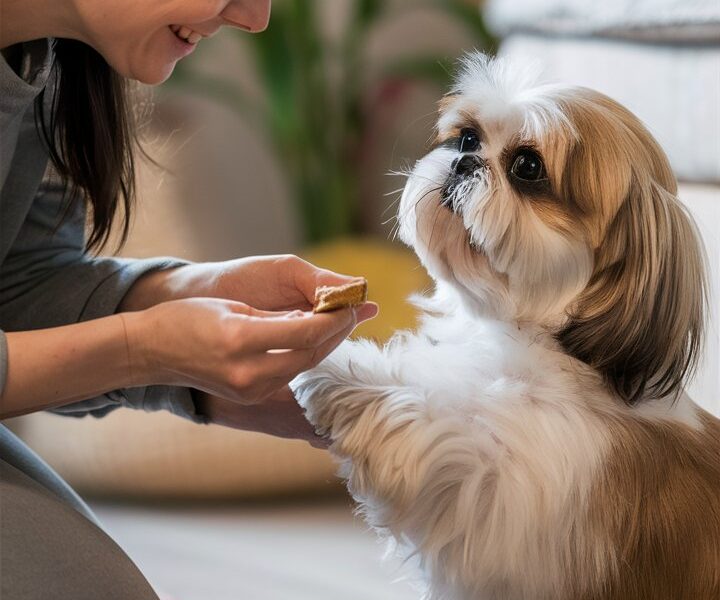Shih Tzus are one of the most adorable and affectionate small dog breeds, but they are also known for their stubborn streak. Training them requires patience, consistency, and an understanding of their unique temperament. Unlike larger working breeds, Shih Tzus don’t train well with harsh methods—they respond best to positive reinforcement, short sessions, and lots of love.
This step-by-step training guide is designed to give you everything you need to raise a well-behaved, happy Shih Tzu. From puppyhood to adulthood, you’ll learn proven methods tailored specifically to this breed.
🐾 Understanding the Shih Tzu Temperament
Before you start training, you need to understand how a Shih Tzu thinks:
- Stubborn but not aggressive → They may ignore you, but rarely act out violently.
- Companion-driven → They love human attention and bond deeply with their owners.
- Sensitive and emotional → Harsh tones or punishment can cause them to shut down.
- Short attention span → They learn best in 5–10 minute training sessions.
- Smart and observant → They quickly learn routines and cues if training is consistent.
✅ Pro Tip: Your Shih Tzu won’t respond to dominance-based training. Think of yourself as a kind teacher, not a strict master.
📅 Step-by-Step Training Timeline
1. 8–12 Weeks: Socialization & Potty Training
- Introduce your puppy to different people, sounds, and gentle dogs.
- Start housebreaking: take them outside every 2–3 hours, after meals, and after naps.
- Begin crate training to help with routine and prevent accidents.
- Teach their name and basic recall with treats.
2. 3–6 Months: Basic Obedience
- Commands to start with: sit, stay, come, down.
- Use hand signals along with verbal cues.
- Begin leash training → use a lightweight harness, not a collar (to protect their neck).
- Keep sessions short and rewarding.
3. 6–12 Months: Advanced Training & Problem Solving
- Add commands: leave it, wait, heel, quiet.
- Introduce clicker training for precision.
- Work on impulse control (waiting before meals, not rushing out the door).
- Address common issues:
- Barking at strangers → reward quiet behavior.
- Chewing → redirect with toys.
- Pulling → stop walking until they calm.
4. 1 Year and Beyond: Refinement & Consistency
- Reinforce all previously learned commands.
- Rotate training games to keep things fun.
- Manage separation anxiety with gradual alone-time training.
- Continue socialization with new environments.
✅ Pro Tip: Training never really ends. Even adult Shih Tzus benefit from regular practice.
🍖 The Science of Positive Reinforcement
Shih Tzus thrive when training feels like a game with rewards.
- Why it works: Rewards release dopamine, strengthening memory and behavior patterns.
- Best rewards for Shih Tzus:
- Small, soft, low-calorie treats
- Gentle praise (“Good girl/boy!”)
- Short playtime with a favorite toy
- Avoid: Harsh punishment, yelling, or physical correction—these break trust.
🐶 Common Training Challenges (and Solutions)
1. Potty Training Struggles
- Stick to a consistent schedule.
- Reward immediately after success.
- Use puppy pads indoors if outdoor access is limited.
2. Barking at Strangers
- Train “quiet” using treats when they stop barking.
- Desensitize them by exposing them gradually to triggers.
3. Leash Pulling
- Use a no-pull harness.
- Stop walking until they relax, then reward forward movement.
4. Separation Anxiety
- Start with 5-minute absences, gradually increase.
- Leave a safe toy or puzzle feeder.
5. Ignoring Commands
- Keep sessions fun, short, and consistent.
- Increase treat value (e.g., chicken instead of kibble).
🏆 Advanced Training Tips for Shih Tzus
Most guides stop at basics—here’s how to go further:
- Hand Signals + Verbal Cues: Shih Tzus respond well to dual communication.
- Clicker Training: Helps mark desired behaviors with precision.
- Indoor Obedience Games: Perfect for apartment living.
- Trick Training: Shih Tzus excel at fun tricks like “spin” or “wave.”
📋 Quick Training Checklist
✅ Short, daily sessions (5–10 minutes)
✅ Always end on a positive note
✅ Use high-value treats for difficult commands
✅ Be patient—progress is slower than with working breeds
✅ Socialize early and often
❓ FAQs About Training a Shih Tzu
Q: Are Shih Tzus hard to train?
A: They can be stubborn, but with positive reinforcement and consistency, they train very well.
Q: How long does it take to potty train a Shih Tzu?
A: With consistency, expect 3–6 months for full reliability.
Q: Can Shih Tzus learn tricks?
A: Yes! They love trick training as long as it’s fun and reward-based.
Q: Should I use a collar or harness?
A: Always use a harness—their short necks make collars risky.
✅ Final Thoughts
Training a Shih Tzu is not about dominance—it’s about patience, consistency, and love. With the right approach, your Shih Tzu will become a well-mannered, affectionate companion.
By following this step-by-step guide, you’ll not only raise a trained dog but also deepen your bond with your Shih Tzu. Remember: training is a lifelong journey, and every small success counts.




